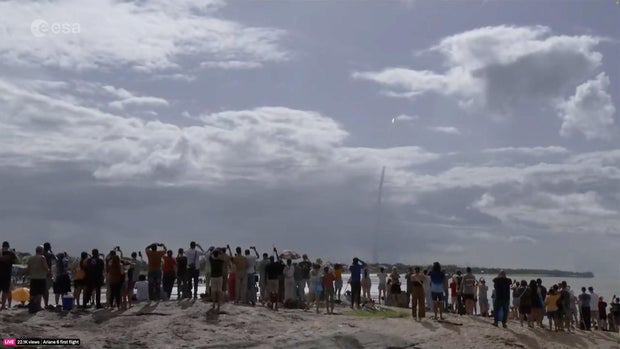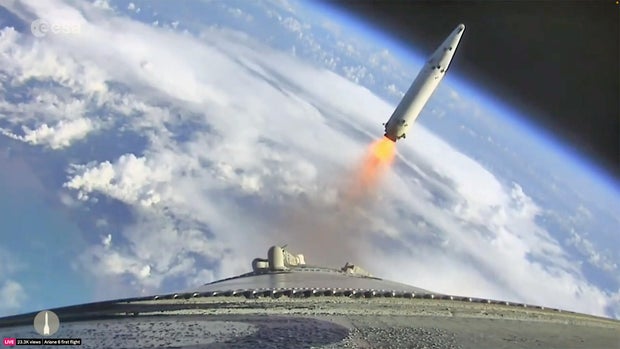CBS News
Europe launches maiden flight of Ariane 6 rocket

Running years behind schedule, Europe’s new Ariane 6 rocket blasted off on its maiden flight Tuesday, thundering away from the European Space Agency’s jungle launch site in French Guiana in a bid to restore independent European access to space.
Facing increasingly stiff international competition, Europe’s space agencies see the Ariane 6 as critical to re-establishing and maintaining their foothold in low-Earth orbit and beyond, launching European military satellites, science missions, navigation and communications satellites and other commercial payloads.
ESA webcast
“Ariane 6 will power Europe into space,” ESA Director General Josef Aschbacher said in a post on X. “This is just the first step, we have lots of work to do yet, but we are laser-focused on changing the future of the European space transportation ecosystem.”
Despite cloudy weather and area showers, the 183-foot-tall rocket’s hydrogen-fueled Vulcain 2.1 main engine roared to life at 3 p.m. EDT, followed a few seconds later by ignition of two solid-fuel strap-on boosters, each one generating 787,000 pounds of thrust.
The Ariane 6 majestically climbed skyward atop a combined 1.9 million pounds of thrust, shattering the afternoon calm at the Guiana Space Center and putting on a spectacular, long-awaited show for government and industry dignitaries, launch site personnel and area residents.
Disappearing behind low clouds, the two strap-on boosters burned out and fell away two minutes after liftoff. The Vulcain 2.1 main engine, producing 308,000 pounds of push, continued firing for another five minutes before it, too, shut down and the stage fell away, plunging back into the atmosphere where it was expected to break up.
ESA webcast
The rocket’s second stage then continued the climb to space. After two firings of its restartable, hydrogen-fueled Vinci engine, the upper stage reached its planned 360-mile-high initial orbit one hour after takeoff.
For its maiden flight, the Ariane 6 carried multiple small payloads provided by ESA, NASA, industry, research institutes and students. Among nine deployable satellites were two small experimental re-entry capsules designed to test new heat shield technologies, and two NASA “cubesats” built to study radio waves emitted by powerful solar flares.
Three upper stage engine firings were planned over the course of the two-hour 40-minute mission.
Assuming telemetry confirms a successful maiden flight, a second launch is planned before the end of the year. Six flights are booked for 2025, eight flights in 2026 and 10 in 2027. After working off the current backlog, the European space managers expect to maintain a “steady state” of nine launches per year.
“What a giant leap forward for @ESA with the first launch of its powerful, next-generation rocket-and with a @NASASun scientific instrument onboard,” NASA Administrator Bill Nelson said in a post on X. “Together with our international partners, we are leading a new era of space exploration.”
The Ariane 6’s launching marked a major milestone for the 13-nation European Space Agency, prime contractor ArianeGroup, the French space agency CNES, which built the launch pad, and Arianespace, the consortium that sells and manages Ariane flights.
The rocket’s predecessor, the venerable Ariane 5, was retired last year after 117 flights, including the 2021 launch of the James Webb Space Telescope. The Ariane 6 is roughly comparable to the Ariane 5, but uses upgraded components and is expected to cost 40% less to build and operate.
But unlike SpaceX, which dominates the current launch market with reusable first stages and payload fairings, the Ariane 6 is fully expendable and no components are recovered. Toni Tolker-Nielsen, ESA director of space transportation, recently told Space News that “our launch needs are so low that (reusability) wouldn’t make sense economically.”
“We don’t really need it at this point,” he said. “But when we’ll launch frequently in the future, we’ll need reusability for economic reasons. The second reason to have reusability for a European launcher is sustainability. We must have a circular economy in 10 or 20 years, we need to be sustainable.”
ESA webcast
The Ariane 6 originally was expected to fly in 2020, but a series of economic and technical hurdles combined to delay the maiden flight by four years.
In the meantime, a joint program with the Russian space agency Roscosmos — launching medium-lift Soyuz rockets from French Guiana — fell apart after Russia’s invasion of Ukraine. Adding insult to injury, Europe’s small Vega-C rocket was grounded after its second launch ended in failure.
And so, since the Ariane 5’s final flight last July, Europe has not had its own rockets to launch European payloads. Indeed, at least four satellites originally slated to fly aboard European launchers were instead carried to orbit aboard SpaceX Falcon 9 rockets.
“You don’t want to depend on anybody, and that’s why all spacefaring nations want their own access to space,” Lucia Linares, director of space transportation strategy and institutional launches for ESA, said in remarks quoted by Nature magazine.
Two variants of the Ariane 6 are planned: one with two strap-on boosters, the Ariane 62, and a more powerful version, the Ariane 64, with four strap-on boosters. A variety of payload fairings are available to accommodate different payload sizes.
Tolker-Nielsen said this “modular” system is ideal from Europe’s perspective.
“It’s a perfect system because Ariane 62 is replacing the Russian Soyuz, and Ariane 64 is replacing Ariane 5,” he said. “So it covers all our needs. Ariane 6 could be the European workhorse for the next 15 to 30 years.”
CBS News
Trump makes more Cabinet picks but some top economic posts remain unfilled

Watch CBS News
Be the first to know
Get browser notifications for breaking news, live events, and exclusive reporting.
CBS News
Open: This is “Face the Nation with Margaret Brennan,” Nov. 24, 2024

Watch CBS News
Be the first to know
Get browser notifications for breaking news, live events, and exclusive reporting.
CBS News
Popular gluten free tortilla strips recalled over possible contamination with wheat

A food company known for popular grocery store condiments has recalled a package of tortilla strips that may be contaminated with wheat, the U.S. Food and Drug Administration said Friday. The product is meant to be gluten-free.
Sugar Foods, a manufacturing and distribution corporation focused mainly on various toppings, artificial sweeteners and snacks, issued the recall for the “Santa Fe Style” version of tortilla strips sold by the brand Fresh Gourmet.
“People who have a wheat allergy or severe sensitivity to wheat run the risk of serious or life-threatening allergic reaction if they consume the product,” said Sugar Foods in an announcement posted by the FDA.
Packages of these tortilla strips with an expiration date as late as June 20, 2025, could contain undeclared wheat, meaning the allergen is not listed as an ingredient on the label. The Fresh Gourmet product is marketed as gluten-free.
Sugar Foods said a customer informed the company on Nov. 19 that packages of the tortilla strips actually contained crispy onions, another Fresh Gourmet product normally sold in a similar container. The brand’s crispy onion product does contain wheat, and that allergen is noted on the label.
U.S. Food and Drug Administration
No illnesses tied to the packaging mistake have been reported, according to the announcement from Sugar Foods. However, the company is still recalling the tortilla strips as a precaution. The contamination issue may have affected products distributed between Sept. 30 and Nov. 11 in 22 states: Arizona, California, Colorado, Florida, Georgia, Iowa, Idaho, Illinois, Indiana, Maryland, Maine, Michigan, Minnesota, North Carolina, New Jersey, Ohio, Oregon, Pennsylvania, Texas, Utah, Virginia and Washington.
Sugar Foods has advised anyone with questions about the recall to contact the company’s consumer care department by email or phone.
CBS News reached out to Sugar Foods for more information but did not receive an immediate reply.
This is the latest in a series of food product recalls affected because of contamination issues, although the others involved harmful bacteria. Some recent, high-profile incidents include an E. coli outbreak from organic carrots that killed at least one person in California, and a listeria outbreak that left an infant dead in California and nine people hospitalized across four different states, according to the Center for Disease Control and Prevention. The E. coli outbreak is linked to multiple different food brands while the listeria outbreak stemmed from a line of ready-to-eat meat and poultry products sold by Yu-Shang Foods.











